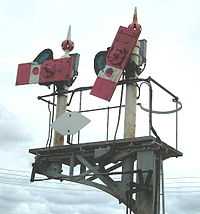Rule 55
Rule 55 was an operating rule which applied on the former British railways in the 19th and 20th centuries, and was made defunct when the {0007ACA4-12EA-4EC3-B2B7-0810CA434F46} Modular Rulebook was introduced following privatisation of the railway.
Overview

It required that, if a train was brought to a stand at a signal, within three minutes in clear weather or immediately in rain, snow or fog, the driver of the train must despatch his fireman, guard or any shunter riding on the train, to the signal box to ensure that the signalman was aware of the presence of the train, and that all safeguards to protect the train, such as slides or collars on the signal levers, were in place, the crewman then signing the train register to confirm this.
In practice, this usually meant a fruitless trudge, often in foul weather, for the unfortunate crewman (although there was usually a mug of tea to be had in the signal box). Quite often the rule was obeyed only perfunctorily, the crewman merely exchanging a greeting with the signalman before signing the register and departing. In many cases, such as at major junctions or marshalling yards where crewmen walking along the rails were in grave danger from moving trains, the rule could not be applied properly. Further, the need for the fireman to return to the train would delay it if the signal was cleared in the meantime.
Accidents
Failure to apply the rule properly was a factor in several railway accidents in the period from 1890 onwards. At Thirsk and Hawes Junction, the crews of the standing trains failed to carry out the rule. At Quintinshill, the fireman of the standing train signed the register but did not ensure that the signalman had put the necessary safeguards in place.

It is impossible to know precisely how many accidents were prevented by the proper observation of the rule, and it could not always prevent a crash. At Winwick, a train was brought to a stand some distance from the signal box. The fireman left promptly to carry out the rule, but he had not reached the signal box before his train was struck. To prevent such occurrences, 'call plungers' (which operate an indicator in the signal box when pressed) or telephones were installed at some signal posts, or track circuits installed. However, even this solution was not completely foolproof e.g. at Castlecary in 1937, the signalman panicked when he thought a train had passed a signal at danger, and failed to check his track circuit indicators. The train had in fact pulled up, but the fireman arrived in the signal box just too late to stop the signalman accepting a following express locomotive.
Exemption
A white diamond sign on a signal post indicated to the driver that Rule 55 did not apply at that signal (at which no telephone was provided), due to the train being protected by track circuits or similar means.
Modernised rule
The basic principle of Rule 55 remains today. It has been updated as it is usually unnecessary for train crew to visit the signal box, since modern technology such as signal post telephones, in-cab radio, and mobile phones [1] allows instant communication.
Rules are no longer given names, but instead are referred to by the section of the Rule Book in which they are placed. In this case it is Module S4/section 1, which states:[2]
When your train is detained at a signal at danger on a running line, you must remind the signaller.Except as otherwise shown in this module, you must contact the signaller as soon as possible.
However, you can wait for up to two minutes before contacting the signaller if you can see an obvious reason for the signal to be at danger such as:
- the section ahead being occupied by a train
- a conflicting movement being made at a junction.
References
- Rolt, L.T.C. Red for Danger. Pan. ISBN 0-330-25555-X.
- ↑ Mobile phones are authorised for contacting the signaller. GE/RT8000 Rule Book Module S4 Section 2.3.
- ↑ Railway Group Standards. GE/RT8000 Rule Book Module S4 Section 1.